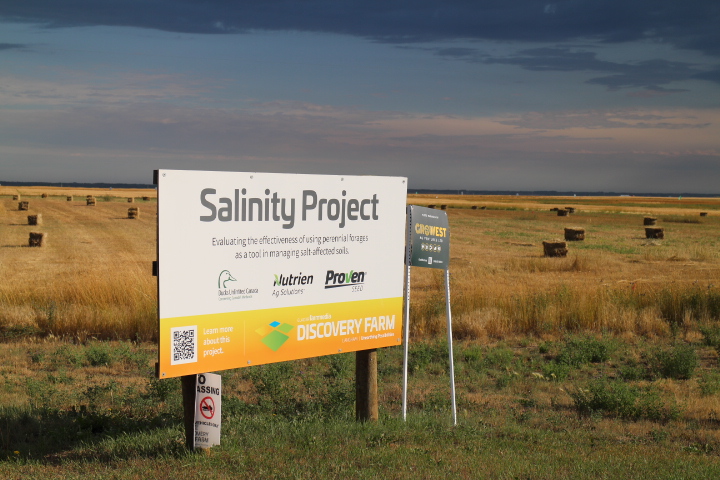The big question is: Can perennial forages be used as a tool to manage salt-affected soils in Western Canada? The Salinity Project exists to find out.
Now in its fifth season at Discovery Farm Langham, this five-year project spans across two acres and is evaluating the measurable changes in soil properties which will allow for observation of how the varying management practices influence the surface soil layer. Treatments being evaluated in this study include Halo 2 Alfalfa, AC Saltlander green wheatgrass, and a blend of perennial species sold as Salinemaster.
In the first four seasons, this project has shown strong establishment of perennial forages on salt-affected soils – even demonstrating great productivity and profitability under harsh drought conditions. Plus, the forage treatments competed against challenging weeds that were initially present at the site such as kochia and foxtail barley.
In 2024, nitrogen and phosphorus fertilizer will be applied to this project to maintain the long-term productivity of the forage stand. Biomass yield and impacts on surface soil characteristics will also continue to be explored in 2024.
Project Report
INTRODUCTION
After witnessing poor crop growth in areas of the field affected by elevated soil salinity, Discovery Farm committed to investigating ways to manage these marginal areas. The use of perennial forages was identified as a potential tool based on its low cost and relative ease of implementation. A secondary objective was to evaluate different treatments of perennial forage species, either grown alone or as a species mix. The treatments included 1) AC Saltlander, 2) Halo2 Alfalfa, and 3) Salinemaster—a proprietary blend of species consisting of 40% AC Saltlander Green Wheatgrass; 30% Barelite Tall Fescue; 20% hps® Smooth Bromegrass; and 10% Revenue Slender Wheatgrass. The treatments were seeded in May of 2020 and all have seen good production beginning in 2021.
RESULTS
Growing Season Conditions
Total precipitation (mm) and mean temperature (℃) are shown by month over the growing season for the last three field seasons, along with the 30-year historical mean.

Dry Biomass Yield
Yield results from the last three field seasons (2022-2024) are shown below. The 2024 season was the most productive of the last three years, with all treatments yielding more than 6,600 kg ha-1 and only a 313 kg ha-1 spread between the highest yielding AC Saltlander (6,934 kg ha-1) and the lowest yielding Halo 2 Alfalfa (6,621 kg ha-1). The high yields from 2024 were explained by the favourable growing season conditions, including much greater early season (May and June) precipitation compared to the previous two years, which beyond providing necessary moisture for biomass production, would have helped in reducing the adverse impacts of salinity. This early season precipitation was coupled with elevated available soil Nitrogen and Phosphorus across the project area, reflecting the fertilizer application that was implemented in the spring of 2022 and 2023 to maintain the soil fertility in this long-term perennial forage project.

Fall surface (0-15 cm) soil test results from samples collected in a transect across the project area.

CONCLUSION
In the fifth growing season of this project, the productivity of the perennial forage treatments has been maintained through appropriate fertilization. The 2024 season was particularly productive for all three treatments given the early-season precipitation that occurred, which likely lessened the relative yield benefit of the deep-rooted Halo 2 alfalfa that was experienced in 2022 and 2023.



This project is a collaborative effort with the following partners: Ducks Unlimited Canada, Nutrien Ag Solutions and Proven Seed.
PARTNERS


Access the Discovery Farm Langham Field Reports
The Field Reports are an annual overview of all activities that happened at Discovery Farm Langham during the growing season including demonstration research, events and knowledge transfer.